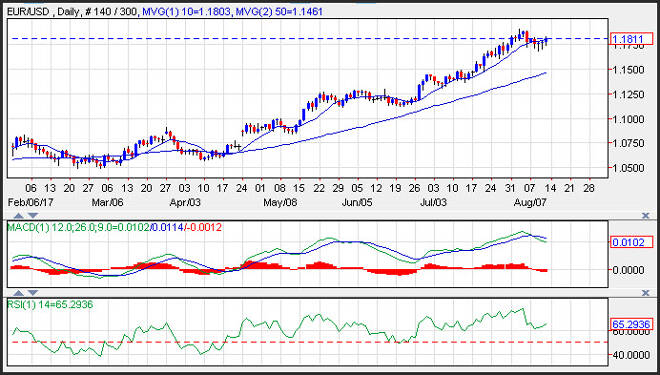Advertisement
Advertisement
EUR/USD Daily Technical Analysis for August 14, 2017
By:
The EUR/USD edged higher, as the dollar eased, following softer than expected consumer inflation, which was also the case throughout Europe. U.S. yields
The EUR/USD edged higher, as the dollar eased, following softer than expected consumer inflation, which was also the case throughout Europe. U.S. yields moved lower, with the 10-year dropping below the 2.2% level, and pushing the yield differential in favor the Euro.
Technicals
The EUR/USD edged higher on Friday moving in tandem with the 10-day moving average which is seen as short-term support near 1.1803. additional support is seen near the 50-day moving average at 1.1461. Resistance is near last week’s highs at 1.1910. Momentum on the currency pair remains negative as the MACD (moving average convergence divergence) index recently generated a crossover sell signal. The MACD histogram is printing in the red with a downward sloping trajectory which points to a lower exchange rate.
U.S. CPI Rose Less than Expected
U.S. headline CPI rose 0.1% in July for both the headline and core rates. There were no revisions to June, where the headline price reading was unchanged while the core edged up 0.1%. Compared to last July, headline prices picked up a bit to a 1.7% year over year pace versus 1.6% year over year, while the ex-food and energy component was flat at a 1.7% year over year clip. The guts of the report showed modest changes. Energy prices dipped 0.1% from the prior -1.6% reading, and is a third straight monthly drop. Transportation costs were also off 0.1% following June’s 0.7% decline.
German Inflation Was in Line with Expectations
German July HICP inflation was confirmed at 1.5% year over year, unchanged from the preliminary number and from June. The national CPI rate meanwhile was confirmed at 1.7% year over year, up from 1.6% year over year in the previous month. Annual heating oil price increases picked up again in July, and overall household energy rose 0.7% year over year, after falling -0.1% year over year in June. Food price inflation meanwhile fell slightly back, although at 2.7% year over year it remains at high levels. Overall the German HICP rate remains above the Eurozone average, as the labor market is looking increasingly tight and the number of vacancies rose to post-unification highs. Still, even the German HICP rate is clearly below the ECB’s upper limit for price stability and the data won’t change the ECB’s cautious stance.
French Inflation is Subdued
French HICP inflation was confirmed at just 0.8% year over year, national CPI stood at an even lower 0.7% year over year in July. A confirmation of the preliminary numbers that leaves the French headline rate not just clearly below the ECB’s upper limit for price stability, but also far below the Eurozone average. The gap of 0.7% points between the German and the French HICP rates highlights the ECB’s problem as so far inflation rates haven’t converged to an extent officials had hoped at the start of the monetary union. Meanwhile payrolls and wage data for the second quarter show that the trend of improving labor markets, but sluggish wage growth remains unchanged, leaving Draghi time to ponder his options for the future of the QE program which currently is only scheduled until the end of the year.
Italian Inflation Confirmed
Italian HICP inflation was confirmed at 1.2% year over year, in line with the preliminary number and unchanged from June. Not surprise there. The annual rate is a tad below the Eurozone average and far below the ECB’s upper limit for price stability of 2%. With unemployment still high, wage growth also remains subdued, leaving the ECB cautious on committing to full blown tapering just yet.
Better than Expected Deficit Recorded by the U.S. Treasury
U.S. Treasury recorded a -$42.9 billion deficit in July, better than expected and about one-third of the -$112.8 billion shortfall a year ago. Receipts rose 10.5% year over year, compared to the 6.9% year over year drop last year, while outlays declined 14.8% year over year versus the -13.8% year over year previously. For the 10 months of the fiscal year-to-date, the red ink totals -$566.0 billion versus -$512.0 billion for the same period last year.
Dudley Says Productivity is Capping Wage Growth
Fed’s Dudley said that sluggish productivity is damping wages, despite job gains, he wrote in the text of his press briefing. Though the post-crisis expansion is the third longest on record, it has been at a relatively weak pace, along with wages. He still expects inflation to rise to the 2% target over the medium term.
About the Author
David Beckerauthor
David Becker focuses his attention on various consulting and portfolio management activities at Fortuity LLC, where he currently provides oversight for a multimillion-dollar portfolio consisting of commodities, debt, equities, real estate, and more.
Advertisement
